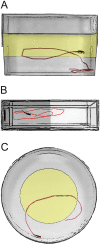Making Waves: New Developments in Toxicology With the Zebrafish
- PMID: 29471431
- PMCID: PMC5920287
- DOI: 10.1093/toxsci/kfy044
Making Waves: New Developments in Toxicology With the Zebrafish
Abstract
The laboratory zebrafish (Danio rerio) is now an accepted model in toxicologic research. The zebrafish model fills a niche between in vitro models and mammalian biomedical models. The developmental characteristics of the small fish are strategically being used by scientists to study topics ranging from high-throughput toxicity screens to toxicity in multi- and transgenerational studies. High-throughput technology has increased the utility of zebrafish embryonic toxicity assays in screening of chemicals and drugs for toxicity or effect. Additionally, advances in behavioral characterization and experimental methodology allow for observation of recognizable phenotypic changes after xenobiotic exposure. Future directions in zebrafish research are predicted to take advantage of CRISPR-Cas9 genome editing methods in creating models of disease and interrogating mechanisms of action with fluorescent reporters or tagged proteins. Zebrafish can also model developmental origins of health and disease and multi- and transgenerational toxicity. The zebrafish has many advantages as a toxicologic model and new methodologies and areas of study continue to expand the usefulness and application of the zebrafish.
Figures



Similar articles
-
Zebrafish (Danio rerio): A valuable tool for predicting the metabolism of xenobiotics in humans?Comp Biochem Physiol C Toxicol Pharmacol. 2018 Oct;212:34-46. doi: 10.1016/j.cbpc.2018.06.005. Epub 2018 Jun 30. Comp Biochem Physiol C Toxicol Pharmacol. 2018. PMID: 29969680 Review.
-
Application of Caenorhabditis elegans (nematode) and Danio rerio embryo (zebrafish) as model systems to screen for developmental and reproductive toxicity of Piperazine compounds.Toxicol In Vitro. 2017 Oct;44:11-16. doi: 10.1016/j.tiv.2017.06.002. Epub 2017 Jun 26. Toxicol In Vitro. 2017. PMID: 28595837
-
Zebrafish: an animal model for toxicological studies.Curr Protoc Toxicol. 2003;Chapter 1:Unit1.7. doi: 10.1002/0471140856.tx0107s17. Curr Protoc Toxicol. 2003. PMID: 23045087
-
Teratological and Behavioral Screening of the National Toxicology Program 91-Compound Library in Zebrafish (Danio rerio).Toxicol Sci. 2019 Jan 1;167(1):77-91. doi: 10.1093/toxsci/kfy266. Toxicol Sci. 2019. PMID: 30364989 Free PMC article.
-
Using zebrafish in systems toxicology for developmental toxicity testing.Congenit Anom (Kyoto). 2016 Jan;56(1):18-27. doi: 10.1111/cga.12142. Congenit Anom (Kyoto). 2016. PMID: 26537640 Review.
Cited by
-
Toxicity of Titanium Dioxide-Cerium Oxide Nanocomposites to Zebrafish Embryos: A Preliminary Evaluation.Toxics. 2023 Dec 6;11(12):994. doi: 10.3390/toxics11120994. Toxics. 2023. PMID: 38133395 Free PMC article.
-
Metabolic disrupting chemicals in the intestine: the need for biologically relevant models: Zebrafish: what can we learn from this small environment-sensitive fish?FEBS Open Bio. 2024 Sep;14(9):1397-1419. doi: 10.1002/2211-5463.13878. Epub 2024 Sep 1. FEBS Open Bio. 2024. PMID: 39218795 Free PMC article. Review.
-
A chemical probe for BAG1 targets androgen receptor-positive prostate cancer through oxidative stress signaling pathway.iScience. 2022 Mar 31;25(5):104175. doi: 10.1016/j.isci.2022.104175. eCollection 2022 May 20. iScience. 2022. PMID: 35479411 Free PMC article.
-
Pamiparib Induces Neurodevelopmental Defects and Cerebral Haemorrhage in Zebrafish Embryos via Inhibiting Notch Signalling.Mol Neurobiol. 2022 Nov;59(11):6652-6665. doi: 10.1007/s12035-022-02988-z. Epub 2022 Aug 19. Mol Neurobiol. 2022. PMID: 35982279
-
Changes in digestive enzyme activities during the early ontogeny of the South American cichlid (Cichlasoma dimerus).Fish Physiol Biochem. 2021 Aug;47(4):1211-1227. doi: 10.1007/s10695-021-00976-z. Epub 2021 Jun 25. Fish Physiol Biochem. 2021. PMID: 34173183
References
-
- Ahmad F., Richardson M. K., Noldus L. P. J. J., Tegelenbosch R. A. J. (2012). Zebrafish embryos and larvae in behavioural assays. Behaviour 149, 1241–1281.
-
- Albadri S., Del Bene F., Revenu C. (2017). Genome editing using CRISPR/Cas9-based knock-in approaches in zebrafish. Methods 121–122, 77–85. - PubMed
Publication types
MeSH terms
Substances
Grants and funding
LinkOut - more resources
Full Text Sources
Other Literature Sources

